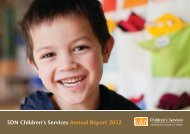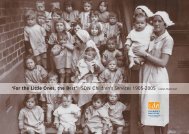SDN Children's Services Inc. Annual Report 2010
SDN Children's Services Inc. Annual Report 2010
SDN Children's Services Inc. Annual Report 2010
Create successful ePaper yourself
Turn your PDF publications into a flip-book with our unique Google optimized e-Paper software.
The environment we operate in<br />
Legislation<br />
Legislation forms the legal basis of all our undertakings. As we<br />
operate in three legal jurisdictions (national, NSW and ACT),<br />
compliance with this wide range of legal requirements adds<br />
to organisational cost. Yet compliance also provides stability<br />
for staff, an assurance of quality and reliability for our clients,<br />
and demonstrates professionalism and competence to our<br />
partners and funders. Our Risk Management Plan incorporates<br />
measures to safely navigate the legal environment in which<br />
we operate. <strong>SDN</strong> is required to comply with 43 pieces of<br />
legislation. The legislation and regulations specific to our<br />
operations include:<br />
National<br />
• Health Records and Information Privacy Act 2002<br />
• Disability Discrimination Act 1992<br />
• Australian and New Zealand Standards: Playground<br />
Surfacing<br />
• Food Standards Australia New Zealand Food Safety<br />
Standards<br />
• Child Care Benefit (Eligibility of Child Care <strong>Services</strong><br />
For Approval And Continued Approval) Amendment<br />
Determination 2001<br />
NSW<br />
• Children and Young Persons (Care And Protection) Act 1998<br />
• Children’s <strong>Services</strong> Regulation 2004<br />
• Disability <strong>Services</strong> Act 1993<br />
• Commission for Children And Young People Act 1998<br />
• Child Protection (Prohibited Employment) Act 1998<br />
ACT<br />
• Children and Young People Act 2008<br />
• Child Care <strong>Services</strong> Standards 2009<br />
<strong>SDN</strong> is represented on major sector bodies and<br />
committees, including:<br />
• Association of Major Community Organisations (AMCO)<br />
• Australian Research Alliance for Children & Youth (ARACY)<br />
• Australian Community Children’s <strong>Services</strong><br />
• NSW Family <strong>Services</strong> Board<br />
• Institute of Early Childhood Advisory Board, Macquarie<br />
University<br />
• Management Committee for the Children and Families<br />
Research Centre, Macquarie University<br />
• National Quality Framework NSW Reference Group<br />
• Early Childhood Australia, (NSW Branch Executive)<br />
• Early Childhood Intervention Australia (NSW Branch)<br />
• Early Childhood Professional Experience Council of NSW<br />
• NSW Children’s <strong>Services</strong> Forum<br />
• Forum of Non Government Agencies<br />
• National Investment for the Early Years (NSW Branch)<br />
Our stakeholders<br />
At <strong>SDN</strong>, our many stakeholders include our children, families,<br />
children’s services providers, Board, staff, government, donors,<br />
members, students, suppliers, professional advisors, media<br />
and the broader community. We encourage professional and<br />
consultative relationships with our stakeholders. We regularly<br />
communicate with stakeholders and look for ways to involve<br />
them in our activities.<br />
Demand for early education and care<br />
More children have been using formal child care services<br />
in recent years. This has been driven by the increasing rate<br />
of female participation in the workforce and higher family<br />
incomes. We expect this trend to continue, aided by the<br />
Australian Government’s increase in the non means tested<br />
Child Care Rebate from 30 percent to 50 percent for families’<br />
out-of-pocket child care costs. Data from the Longitudinal<br />
Study of Australian Children show that those who have<br />
been able to afford formal long day care choose this as their<br />
preferred ‘regular non parental care’ option.<br />
• More than 870 000 Australian children used child care<br />
in the September quarter 2009, an increase of 8 percent<br />
compared with 2005.*<br />
• The number of long day care services increased by 21<br />
percent from the September quarter 2005 to 2009. There<br />
are now 5758 long day care services across Australia.*<br />
• Out-of-pocket child care costs to families decreased from<br />
2004 to 2009 as a result of higher government subsidies.*<br />
‘<br />
Child care is now seen as both a mechanism to support labour<br />
force participation and as an important form of early learning<br />
and education. Consequently, there is now a greater focus on the<br />
quality and experiences that children have within education and<br />
care settings. *<br />
‘<br />
* State of Child Care in Australia, <strong>2010</strong>, Office of Early Childhood<br />
Education and Child Care<br />
Prevention and early intervention<br />
Children from disadvantaged backgrounds are more likely<br />
to develop learning and behaviour problems, and this risk<br />
increases as the children grow older. A 2005 Community<br />
<strong>Services</strong> Literature Review on Prevention and Early Intervention<br />
reported that high quality early childhood education had the<br />
strongest evidence (compared with other strategies) of being<br />
an effective prevention and early intervention strategy for<br />
young children at risk of entering the child protection system.<br />
<strong>SDN</strong> carries a significant proportion of the responsibility for<br />
prevention and early intervention services in NSW, and we<br />
are continuing to build our expertise and profile in this area.<br />
10 <strong>SDN</strong> <strong>Annual</strong> <strong>Report</strong> <strong>2010</strong>





